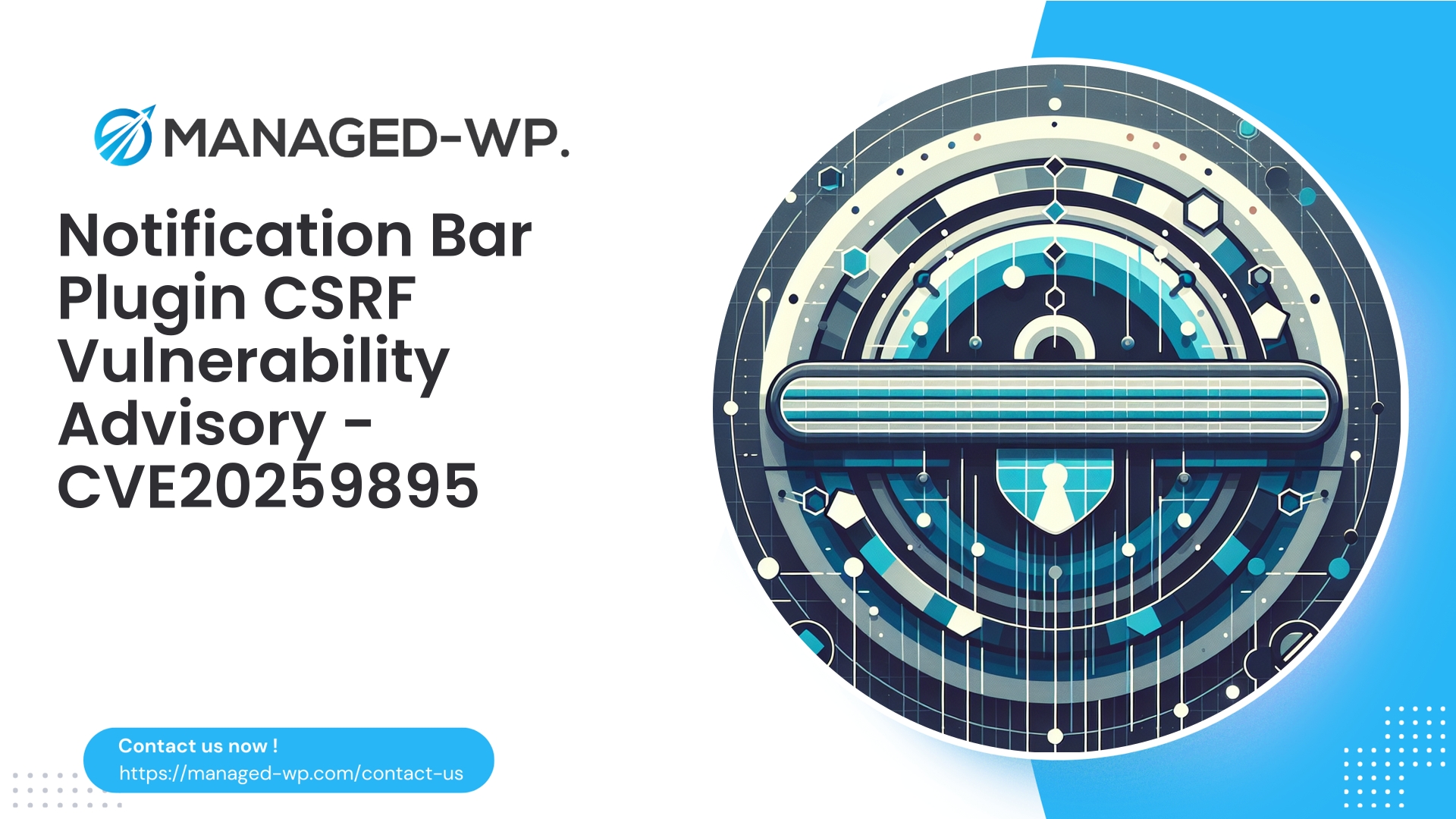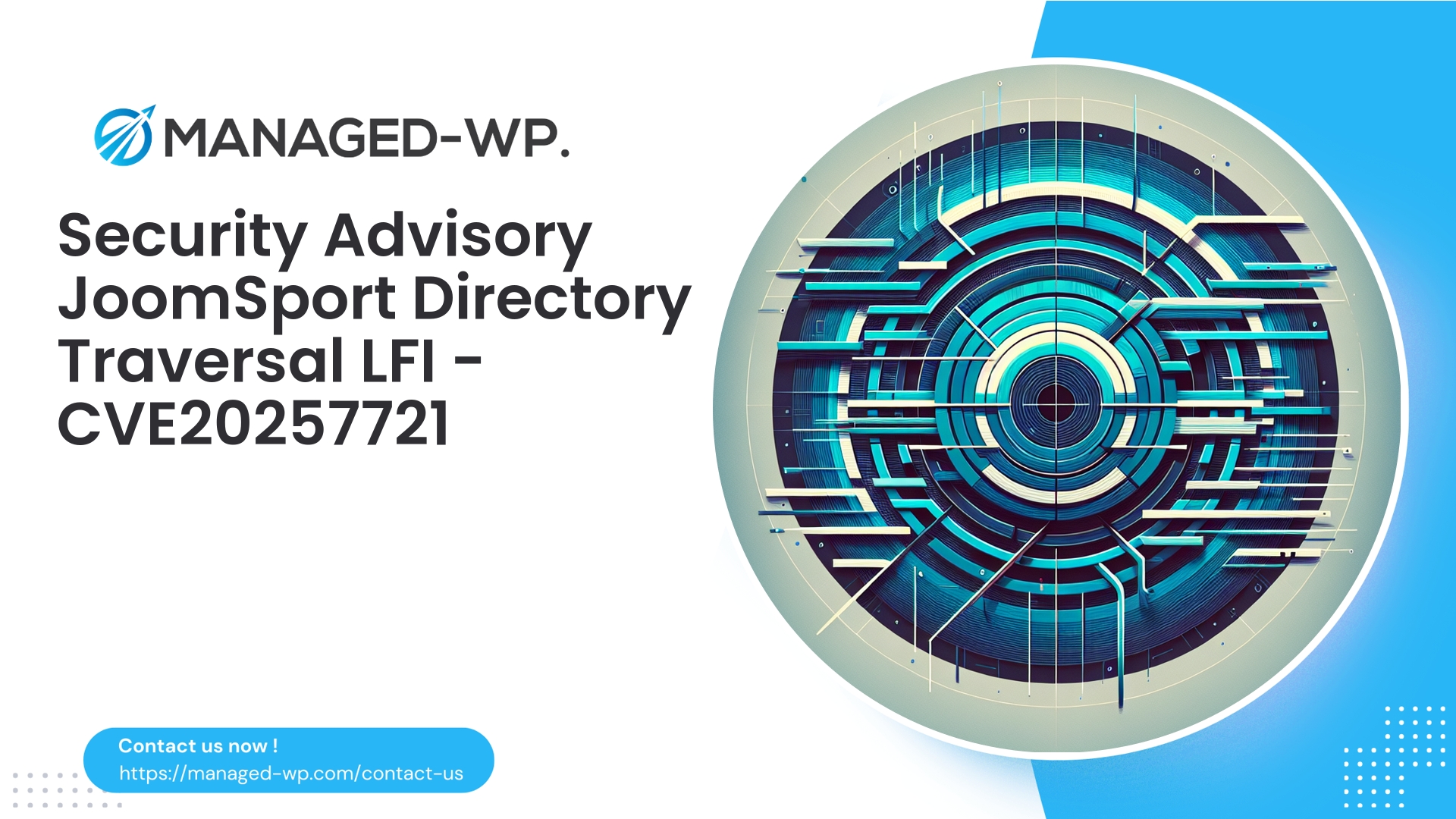| Plugin Name | Notification Bar |
|---|---|
| Type of Vulnerability | CSRF |
| CVE Number | CVE-2025-9895 |
| Urgency | Low |
| CVE Publish Date | 2025-10-03 |
| Source URL | CVE-2025-9895 |
Urgent Security Advisory — Notification Bar plugin (<= 2.2) CSRF Vulnerability (CVE-2025-9895): Essential Actions for WordPress Site Owners and Developers
At Managed-WP, our mission is to protect WordPress sites by providing expert-level security research and managed Web Application Firewall (WAF) services. On October 3, 2025, a Cross-Site Request Forgery (CSRF) vulnerability affecting versions 2.2 and below of the Notification Bar plugin was publicly disclosed and assigned CVE-2025-9895. While the vulnerability is classified as low severity (CVSS score 4.3), it presents a tangible risk due to the nature of CSRF attacks that exploit authenticated sessions to coerce privileged users into unintentional actions.
This advisory breaks down the vulnerability in clear, actionable terms, detailing its behavior, potential impact, detection methods, and immediate steps required by site owners, administrators, and plugin developers. Additionally, it includes recommended virtual patching through WAF rules, developer remediation tips, and an incident response checklist.
Key Summary
- Affected Plugin: Notification Bar (a.k.a. Simple Bar) versions ≤ 2.2
- Vulnerability Type: Cross-Site Request Forgery (CSRF)
- CVE Identifier: CVE-2025-9895
- Disclosure Date: October 3, 2025
- Patch Status: No official security update available yet
- Severity: Low (CVSS 4.3), but mitigation is strongly advised
- Access Required: Unauthenticated attacker lures an authenticated privileged user
Continue reading for a comprehensive understanding of the issue and immediate mitigation recommendations.
Understanding CSRF Attacks: A Practical Explanation
Cross-Site Request Forgery (CSRF) is a technique where attackers trick authenticated users — typically site administrators or editors — into unintentionally executing unwanted actions on a vulnerable site. Common exploits involve injecting malicious HTML or JavaScript into external websites or emails that the victim visits or opens while logged in, triggering unauthorized state-changing operations.
WordPress defends against CSRF by enforcing cryptographic nonces on forms and API endpoints, verified server-side via functions like wp_verify_nonce() or check_admin_referer(). Moreover, capability checks such as current_user_can() ensure only authorized users can perform certain actions.
The Notification Bar plugin in vulnerable versions neglects these essential nonce validations and sometimes lacks consistent permission checks. This gap allows attackers to misuse authenticated user sessions to execute unintended admin operations.
Technical Details of the Vulnerability
Reports confirm the Notification Bar plugin (versions ≤ 2.2) exposes one or more administrative or state-changing actions without adequate CSRF protection, exhibiting these traits:
- Accessible via predictable admin endpoints such as
admin-ajax.phporadmin-post.php. - Absence of nonce verification or oversight of referer headers.
- Inconsistent or missing capability checks for privileged actions.
As a consequence, crafting a malicious webpage that an authenticated administrator visits can trigger backend calls altering the Notification Bar’s content or settings without user intent. While the impact might seem minor, this vulnerability could be chained with social engineering to facilitate more disruptive outcomes.
Note: Some reports state the vulnerability is “unauthenticated.” This indicates attackers do not need credentials themselves but rely on the victim’s authenticated session to exploit the flaw.
Risk and Exploitability Overview
- Likelihood of Exploit: Low to moderate—requires convincing an authenticated user to visit malicious content.
- Impact: Low by CVSS scoring; however, site-specific contexts could escalate consequences.
- Attack Complexity: Low—attackers need only direct an authenticated user to crafted content.
- Exploitation Vector: Malicious websites, emails, embedded iframes, or linked content triggering harmful POST requests.
Organizations with multiple administrators or sensitive content should prioritize mitigation despite the low CVSS rating.
Immediate Recommendations for Site Owners and Admins
If you operate a WordPress site that uses Notification Bar (Simple Bar) plugin, act promptly with the following:
- Inventory Affected Installations
— Check your site(s) under WordPress admin → Plugins for Notification Bar or “simple-bar”.
— Use management tools or WP-CLI to scan multiple sites if applicable. - Deactivate the Plugin Temporarily
— If functionality can be suspended, deactivate the plugin to completely eliminate exposure until an official fix is available. - Implement Mitigations if Deactivation Isn’t Feasible
— Limit admin panel access by IP restrictions.
— Apply server-level rules to restrict or verify plugin admin endpoint requests.
— Enforce two-factor authentication (2FA) on administrator accounts to reduce overall risk. - Force Password Resets and Session Expirations on Suspicion
— Use WordPress user management or WP-CLI to reset passwords and invalidate active sessions. - Monitor for Anomalous Changes
— Watch for unexpected notification content changes or admin settings updates.
— Examine logs for external-origin POST requests targeting plugin endpoints. - Deploy WAF Rules if Available
— Employ virtual patching rules to block or flag malicious plugin admin actions. - Apply Official Plugin Updates Promptly
— Once a vendor patch is released, install it immediately for definitive remediation.
Recommended Managed-WP WAF Virtual Patching
In absence of an official patch, our Managed-WP WAF can protect your site by intercepting and blocking suspicious requests targeting the Notification Bar plugin.
- Prevent POST requests to relevant plugin admin URLs lacking a valid WordPress nonce or originating from external referrers.
- Throttle or deny repeated attempts to inject unexpected admin changes.
- Alert site administrators on suspicious activity attempts for prompt investigation.
Example ModSecurity Conceptual Rule:
# Block POSTs to admin-ajax.php or admin-post.php targeting Notification Bar without nonce
SecRule REQUEST_METHOD "POST" "phase:1,pass,id:100001,chain,log,msg:'Block potential CSRF on Notification Bar plugin'"
SecRule REQUEST_URI "@rx (admin-ajax\.php|admin-post\.php)" "chain"
SecRule ARGS_NAMES|REQUEST_HEADERS:Cookie "!@contains _wpnonce" "t:none,deny,status:403"
Example Nginx Config Snippet:
location ~* /wp-admin/admin-ajax\.php$ {
if ($request_method = POST) {
if ($http_referer !~* "yourdomain\.com") {
return 403;
}
}
# pass to PHP-FPM
}
Note: Customize and test rules carefully to avoid unintended disruptions.
Detection Techniques for Potential Exploitation
Look for indicators such as:
- Unexpected changes to notification texts or plugin settings.
- POST requests logged in access logs from external referers or lacking _wpnonce parameters.
- Admins reporting site behavior anomalies or unexpected notification content.
- Audit your WordPress debug logs and plugin logs for irregular POST activity.
Using WP-CLI, you can query for recent file modification times or manage user sessions for suspicious activities.
Development Best Practices for Remediation
Plugin authors must address the root cause by implementing the following:
- Nonce Validation on All State-Changing Actions
Use WordPress nonce functions such aswp_nonce_field()andcheck_admin_referer()for forms,check_ajax_referer()for AJAX handlers, and verify nonces on admin-post.php handlers. - Capability Checks
Ensurecurrent_user_can()guards all critical operations to restrict access only to authorized roles. - Input Sanitization and Validation
Sanitize all inputs rigorously with appropriate WordPress APIs likesanitize_text_field(),esc_url_raw(), and type validations. - Disallow Unauthenticated Callback Endpoints
Ensure only authenticated users can invoke privileged plugin actions. - Adhere to REST API Security Standards
Employ permission callbacks and nonce validations on REST routes. - Unit and Integration Tests
Automate tests that verify endpoint protection and nonce enforcement.
Sample code snippet (nonce check in POST handler):
<?php
wp_nonce_field( 'simple_bar_save_settings', 'simple_bar_nonce' );
if ( ! isset( $_POST['simple_bar_nonce'] ) || ! wp_verify_nonce( $_POST['simple_bar_nonce'], 'simple_bar_save_settings' ) ) {
wp_die( 'Security check failed: invalid nonce.', 'Security', [ 'response' => 403 ] );
}
if ( ! current_user_can( 'manage_options' ) ) {
wp_die( 'Insufficient permissions.', 'Security', [ 'response' => 403 ] );
}
Incident Response Checklist if Compromise is Suspected
- Isolate the Site
Put the site into maintenance mode or restrict admin area access to trusted IPs. - Preserve Evidence
Backup all site files and databases plus server logs securely without overwriting them. - Scan Thoroughly
Run malware scans and check file integrity for unexpected changes. - Review Logs and Activity
Audit admin actions, new users, cron jobs, and uploads. - Remediate
Deactivate or remove the vulnerable plugin, rotate credentials, restore clean backups where necessary. - Clean and Recover
Reinstall WordPress core and plugin files from trusted sources; reapply security measures. - Ongoing Monitoring
Monitor logs and site behavior for at least 30 days after incident. - Notify Stakeholders
Alert hosting providers and any relevant parties if there’s potential data exposure.
Engage professional incident responders if evidence of deep compromise (e.g., webshells) is found.
Safe Testing to Determine Vulnerability
- Review plugin source code for missing nonce checks or capability validations.
- Perform non-destructive tests in staging environments mimicking attack POST requests.
- Use trusted security scanners designed for WordPress plugins.
Long-Term WordPress Hardening Recommendations
- Keep WordPress core, themes, and plugins updated.
- Remove unused or abandoned plugins.
- Apply least privilege principles to user roles.
- Enable two-factor authentication for all admin users.
- Restrict admin area access by IP when possible.
- Use managed WAF services with virtual patching tailored for WordPress.
- Regularly back up your site and verify restore processes.
- Analyze server and application logs routinely.
- Harden WP configuration by disabling file editing, limiting XMLRPC access, protecting
wp-config.php, etc. - Conduct periodic security assessments for high-value sites.
Why Choose Virtual Patching with Managed-WP’s WAF?
Without a timely official plugin fix, site owners face difficult choices—either accept risk or sacrifice functionality by disabling features. Managed-WP’s expert security team maintains updated WAF signatures that can:
- Block exploit requests targeting the vulnerable Notification Bar plugin based on absence of nonces and suspicious request patterns.
- Alert administrators to attempted exploit activity for quick review.
- Allow sites to maintain operational functionality while significantly reducing risk exposure.
Our virtual patching acts as an immediate shield, buying crucial time until long-term fixes can be applied.
Developer Disclosure and Community Best Practices
- Researchers discovering vulnerabilities should responsibly disclose these privately to plugin maintainers before public announcements.
- Plugin authors are encouraged to maintain a Vulnerability Disclosure Policy (VDP) to facilitate smooth communication and rapid patching.
Log Monitoring and SIEM Rules for Hosts and Advanced Users
Centralized log analysis can highlight potential CSRF exploitation attempts. Suggested SIEM rules include:
- Alert on POST requests to
admin-ajax.phporadmin-post.phpwith external referrer headers and missing_wpnonceparameters. - Detect POSTs with suspicious or automated user agents targeting plugin-related actions.
- Correlate admin POST events with subsequent setting changes for anomalous activity detection.
Example Splunk-style search:
index=web access_combined method=POST (uri="/wp-admin/admin-ajax.php" OR uri="/wp-admin/admin-post.php") NOT _wpnonce | stats count by clientip, uri, referer, useragent
Tailor baselines to reduce false alarms.
Summary and Closing Notes
CVE-2025-9895, a CSRF vulnerability affecting Notification Bar plugin versions up to 2.2, demands proactive attention despite its low CVSS rating. CSRF attacks exploit authenticated sessions — a common scenario as admins browse the web logged in. In the absence of an official patch, prudent site owners should apply layered defenses including plugin deactivation, access restrictions, 2FA enforcement, credential rotation, log monitoring, and managed WAF virtual patching.
Managed-WP’s security team stands ready to assist with mitigation strategies and investigations to protect your WordPress environment.
Action Checklist: What to Do in the Next 24 to 72 Hours
- Confirm whether Notification Bar (simple-bar) is installed on your WordPress site(s).
- Deactivate the plugin immediately if possible.
- If deactivation isn’t possible, enforce admin area IP restrictions and enable two-factor authentication.
- Deploy virtual patch WAF rules blocking unauthenticated or nonce-less POST requests to plugin endpoints.
- Rotate passwords and force resets for all administrative users.
- Create full site backups (files and database) stored securely offsite.
- Monitor server and application logs closely for at least 30 days.
- Install the official plugin update as soon as it is released.
Get Protected Today with Managed-WP’s Free Plan
At Managed-WP, we believe robust WordPress security should be accessible and straightforward. Our Basic (Free) plan offers essential managed firewall protection immediately, including targeted WAF rules, malware scanning, and mitigation against common OWASP Top 10 vulnerabilities. This level of defense is sufficient for many site owners seeking to block common threats and gain peace of mind during vulnerability triage.
Basic (Free) Plan Highlights
- Managed WordPress-tailored WAF rules
- Unlimited bandwidth coverage under protection layer
- Automated malware detection
- Virtual patching against known vulnerabilities
Enhanced paid plans (Standard, Pro) provide automated malware cleanup, IP access controls, detailed security reporting, and comprehensive virtual patching.
To activate immediate WAF protection with our free offering, visit: https://my.wp-firewall.com/buy/wp-firewall-free-plan/
For assistance in configuring WAF rules or investigating suspicious activity, reach out to the Managed-WP security team. Stay vigilant, backup regularly, and treat all plugin vulnerabilities seriously—even those with low severity—because attackers frequently chain minor flaws into more significant compromises.
— Managed-WP Security Team



















